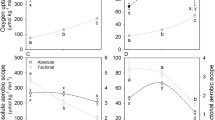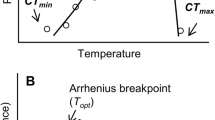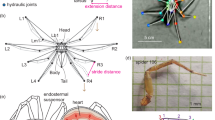Abstract
Antarctic marine invertebrates live in a cold, thermally stable environment and cannot tolerate large changes in body temperature (i.e. they are stenothermal). Their temperate relatives, by contrast, are eurythermal, living in warmer and thermally more variable environments. Have these different environments influenced how specific behaviours are affected by changes of temperature? This question was addressed in two temperate crustaceans, the decapod Carcinus maenas and isopod Ligia oceanica, and two Antarctic crustaceans, the isopod Glyptonotus antarcticus and amphipod Paraceradocus gibber. The thermal dependence of walking speed was analysed by contrasting the slopes of the linear part of each species’ behavioural curve. Over the temperature ranges analysed, the temperature sensitivity of walking speed in the stenotherms was 13–23% that of the eurytherms when measured in body lengths s−1. There was a linear relationship between walking speed and temperature up to +4.5°C in the Antarctic species G. antarcticus and P. gibber. Elevating temperature by up to 3.5°C above the maximum temperature experienced in the Antarctic (+1°C), does not lead to an acute breakdown of motor coordination. We describe for the first time the righting behaviour of G. antarcticus. The mean time-to-right tended to a minimum on warming from −2 to+5°C, but this trend was not statistically significant. Our results suggest that the physiological adaptations which permit continued activity at low Antarctic temperatures have resulted in a lower thermal dependence of activity in Antarctic species, compared to related temperate species.







Similar content being viewed by others
References
Barlow CA, Kerr WD (1969) Locomotory responses to temperature in the grain weevil, Sitophilus granarius (L.) (Coleoptera: curculionidae). Can J Zool 47:217–224
Barnes RSK, Hughes RN (1999) An introduction to behavioural ecology, 3rd Edn. Blackwell, Oxford, 286 pp
Bennett AF (1990) Thermal dependence of locomotor capacity. Am J Physiol 259:253–258
Clarke A (1988) Seasonality in the Antarctic environment. Comp Biochem Physiol B 90:461–474
Coleman CO (1989) Burrowing, grooming and feeding-behaviour of Paraceradocus, an Antarctic amphipod genus (Crustacea). Polar Biol 10:43–48
Davenport JA (1997) Comparisons of the biology of the intertidal subantarctic limpets Nacella concinna and Kerguelenella lateralis. J Moll Stud 63:39–48
Frederich M, Sartoris FJ, Arntz WE, Pörtner H-O (2000) Haemolymph Mg2+ regulation in decapod crustaceans: physiological correlates and ecological consequences in polar areas. J Exp Biol 203:1383–1393
Frederich M, Sartoris FJ, Pörtner H-O (2001) Distribution patterns of decapod crustaceans in polar areas: a result of magnesium regulation? Polar Biol 24:719–723
Gentile G, Argano R (2005) Island biogeography of the Mediterranean sea: the species-area relationship for terrestrial isopods. J Bio geog 32:1715–1726
Hewitt CG (1907) Ligia. XIV. In: Herdman WA (ed) Liverpool Marine Biology Committee. L.M.B.C. memoirs on typical British marine plants and animals. Williams and Norgate, London, 37 pp
Kivivuori L (1980) Effects of temperature and temperate acclimation on the motor and neural functions in the crayfish Astacus astacus L. Comp Biochem Physiol 65A:297–304
Lagerspetz KYH, Tiiska A (1996) Why are some substances more toxic for Dapnia magna at low temperatures? Why magnesium? In: adaptations to stress in aquatic and terrestrial ecosystems, European Society for Comparative Physiology and Biochemistry, 17th annual conference, Abstracts, p 185
Lindström M, Fortelius W (2001) Swimming behaviour in Monoporeia affinis (Crustacea: Amphipoda)—dependence on temperature and population density. J Exp Mar Biol Ecol 256:73–83
McKenzie JD, Colow P, Clyde J, Miles A, Dickinson R, Lieb WR, Franks NP (1992) Effects of temperature on the anaesthetic potency of halothane, enflurane and ethanol in Daphnia magna (Cladocera: Crustacea). Comp Biochem Physiol 101C:15–19
McLeese DW, Wilder DG (1958) The activity and catchability of the lobster (Homarus americanus) in relation to temperature. J Fish Res Bd Can 15:1345–1354
Mellanby K (1939) Low temperature and insect activity. Proc R Soc Lond B 127:473–486
Pantin CFA (1946) Notes on microscopical techniques for zoologists. Cambridge University Press, Cambridge, 75 pp
Pörtner H-O (2002) Climate variations and the physiological basis of temperature dependent biogeography: systemic to molecular hierarchy of thermal tolerance in animals. Comp Biochem Physiol A 132:739–761
Prosser CL (1958) General summary: the nature of physiological adaptation. In: Prosser CL (ed) Physiological adaptation. Society of General Physiologists, American Physiology Society, Washington, pp 167–180
Ropes JW (1968) The feeding habits of the green crab, Carcinus maenas (L.). Fish Bull Wildl Serv US 67:183–203
Schram FR (1986) Crustacea. Oxford University Press, Oxford, 606 pp
Somero GN, DeVries AL (1967) Temperature tolerance of some Antarctic fishes. Science 156:257–258
Somero GN, Dahlhoff E, Lin JJ (1996) Stenotherms and eurytherms: mechanisms establishing thermal optima and tolerance ranges. In: Johnston IA, Bennett AF (eds) Animals and temperature: phenotypic and evolutionary adaptation. Society for Experimental Biology Seminar Series 59. Cambridge University Press, Cambridge, pp 435
Spicer JI, Morritt D, Taylor AC (1994). Effect of low temperature on oxygen uptake and haemolymph ions in the sandhopper Talitrus saltator (Crustacea: Amphipoda). J Mar Biol Ass UK 74:313–321
Symons PEK (1964) Behavioural responses of the crab Hemigrapsus oregonensis to temperature, diurnal light variation, and food stimuli. Ecology 45:580–591
Thatje S, Arntz WE (2004) Antarctic reptant decapods: more than a myth? Polar Biol 27:195–201
Thatje S, Schnack-Schiel S, Arntz WE (2003) Developmental trade-offs in Subantarctic meroplankton communities and the enigma of low decapod diversity in high southern latitudes. Mar Ecol Prog Ser 260:195–207
Thatje S, Anger K, Calcagno JA, Lovrich GA, Pörtner HO, Arntz WE (2005) Challenging the cold: crabs reconquer the Antarctic. Ecology 86:619–625
Wägele JW (1991) Antarctic isopoda Valvifera. In: Wägele JW, Sieg J (eds) Synopses of the Antarctic benthos, vol 2. Koeltz Scientific Books, Koenigstein, 213 pp
Wells RM (1979) The lethal temperatures of Antarctic marine invertebrates. N Z Ant Rec 1:9–13
Willows RI (1987) Population and individual energetics of Ligia oceanica (L.) (Crustacea: Isopoda) in the rocky supralittoral. J Exp Mar Biol Ecol 105:253–274
Wilson RS, Franklin CE, Davison W, Kraft P (2001) Stenotherms at sub-zero temperatures: thermal dependence of swimming performance in Antarctic fish. J Comp Physiol B 171:263–169
Acknowledgments
A BBSRC studentship to J.S.Y. supported this work. We thank the staff of Rothera and Palmer Stations for collection of animals and Lucy Conway for assistance with animal transport and maintenance.
Author information
Authors and Affiliations
Corresponding author
Rights and permissions
About this article
Cite this article
Young, J.S., Peck, L.S. & Matheson, T. The effects of temperature on walking and righting in temperate and Antarctic crustaceans. Polar Biol 29, 978–987 (2006). https://doi.org/10.1007/s00300-006-0140-7
Received:
Revised:
Accepted:
Published:
Issue Date:
DOI: https://doi.org/10.1007/s00300-006-0140-7




